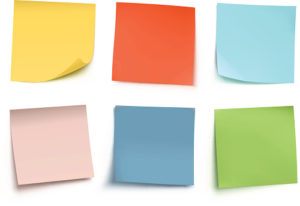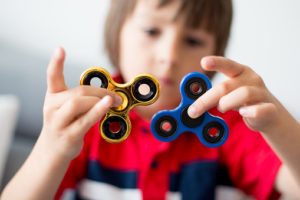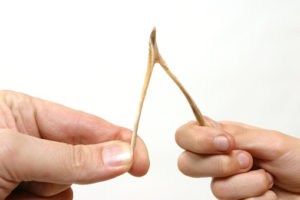Everyone wants to be the one to invent the next big thing. But sometimes, the big things are actually quite small (and sometimes silly). Some of the most profitable new product designs out there are simple and inexpensive to make yet sell in the millions. Here are ten simple products that made people a ton of money—you just might be surprised.
10 Products that Made Millions
1. Post-it Notes
Post-it Notes may be one of the most profitable inventions to date thanks to its low cost and wide range of uses. While marketed as an office supply, it quickly became a household staple. It started out as a simple three-inch yellow square but now comes in tons of different colors and sizes.
What’s interesting is that they are an accidental invention. A scientist by the name of Spencer Silver invented a type of adhesive that wouldn’t permanently stick. Surprising no one, it didn’t sell very well. Another scientist happened to use the adhesive to keep his bookmarks from falling out—thus, the Post-It Note was born.
It first launched under the name “Press ‘n’ Peel” in 1977 to little success. But after a fruitful product test in 1980, the product was renamed, launched, and consequently sold millions. While actual numbers aren’t known, 3M’s consumer product and office division—home to the Post-It Note and Scotch Tape—made $3.47 billion in 2009 while only spending $2.8 million on advertising.
2. Pet Rock
This is truly one of the best—or worst, depending on your take—business ideas of all time. In 1975, after seeing how much his friends complained about their pets, Gary Dahl concluded that the perfect pet was a rock. It wouldn’t have to be fed or walked and it definitely wouldn’t bite.
He wrote a comedic instruction manual detailing how to take care of this hypothetical pet rock and marketed them as if they were actual pets. They came in sleek cardboard boxes that added some legitimacy to an otherwise shady product. The rocks, which came from Mexico, sat on straw in the box, which came complete with air holes.
Dahl’s biggest expense was the box, as the rock only cost one penny and the straw was virtually free. He sold each Pet Rock for $4. By Christmas of 1975, he was a millionaire, although sales declined by February 1976, when the rocks were heavily discounted.
If you’d like your own Pet Rock, Rosebud Entertainment rereleased them in 2012.
3. Bendy Straw
While the original paper straw was quite a groundbreaking invention, the bendy straw took it to another level. Joseph B. Friedman was at a parlor in the 1930s watching his daughter struggle to enjoy a milkshake. Because the straw was straight, she had a hard time comfortably drinking from it.
Friedman enjoyed tinkering, so he took a straw home to see what he could do. To make the ridges in the straw, he inserted a screw into the top and wrapped it in dental floss. When he removed the screw, the straw had those signature ridges and could bend.
He founded the Flex-Straw Company in 1939 and made his first sale in the 40s to a hospital, where patients struggled to use regular straws. Little did he know that he would soon become a multi-millionaire.
4. Slinky
Richard T. James, a naval engineer, came up with the idea for a Slinky in 1943 by pure coincidence—seems like a lot of the best inventions were accidents. He was working with tension springs when he dropped one and noticed how it bounced.
His wife, Betty James, came up with the name. They convinced a department store in Philadelphia to carry 400 Slinky’s for Christmas in 1945 and they sold out within two hours at a dollar a piece. Betty later became CEO of James Industries and is now in the Toy Industry Hall of Fame.
To date, the Slinky has sold over 300 million units and can be found in most homes with children.
5. Slap Bracelet
While they have a bit of a dark past, slap bracelets don’t seem to be going anywhere. Invented in 1983 by high school teacher Stuart Anders, the bracelets were one of the biggest things to hit the 90s.
Slap bracelets were made of long pieces of thinly cut steel and covered in fabric. When slapped on a wrist (or ankle, leg, arm) it turned into a bracelet. It was perfect for the fashion obsessed pre-teen.
Unfortunately, knock-offs made of cheap material quickly entered the market and ruined the fun. Children began to get cut on the sharp steel and thin fabric used by knock-offs and they were promptly banned in some schools. However, the slap bracelets haven’t really gone anywhere, as they can still be found in party stores and online retailers.
6. Fidget Spinners
We don’t know who invented the fidget spinner—Catherine Hettinger was credited for its invention, though that has been debunked—but many companies are making a profit off of the toys.
They’re simple toys that use a ball bearing in the center of some plastic or metal to spin. Marketers claim fidget spinners help people focus and reducing fidgeting, hence the name, although there is no research to back claims of fidget spinners improving mental health.
Fidget spinners are a $500-million-dollar business, although the fad has slowed down over the last few months. It’s hailed as the fastest moving trend in the toy industry in recent years and has created a whole category of toys marketed for fidgeters.
7. Snuggies
We’ve all seen the sleeved blankets that make whoever dons it look like a wizard or cult member. The Snuggie became a marketing success in ’08 and ’09 through infomercials. Sleeved blankets had been on the market for some time, but the Snuggie stomped over the competition to sales of over 30 million units and $500 million dollars.
Before the Snuggie, Gary Clegg created the Slanket. In 2007, he began to regularly appear on the QVC network to market them. Slanket revenue reached $4 million in 2008. Unfortunately, Scott Boilen of the Allstar Marketing Group—responsible for the Snuggie—was able to render the Slanket all but obsolete through expensive and flashy marketing campaigns.
The Snuggie continues to be sold in Australia, the United States, and Canada through infomercials. There are many variations out there. Some are even electronic and have built-in heaters. However, the original Snuggie will always be the best.
8. Beanie Babies
These stuffed animals are different from the rest because they’re stuffed with plastic pellets as opposed to regular stuffing. The “beans” made the Beanie Babies move more realistically, which was the idea behind the product.
They launched in 1993 but Ty Inc. had trouble getting them in stores. However, by 1996, the popularity grew to a point where they had partnered with McDonald’s to release miniature Beanie Babies.
Ty Inc. deliberately produced limited quantities of the designs and retired them, creating huge resell value. Some Beanie Babies began selling on eBay for over 10x their original price, while a select few are worth thousands of dollars.
Ty Inc. became the first billion-dollar stuffed animal company, and Ty Warren is worth over $2.4 billion dollars.
9. Plastic Wishbones
The tradition goes like this: one person holds on to each end of the wishbone, and whoever ends up with the longest half wins and is subsequently granted good luck by the Thanksgiving fairies… or something like that.
Ken Ahroni created the plastic wishbone so that everyone could get in on the fun—after all, there’s only one wishbone per turkey. On Thanksgiving day, most people were left out, but they didn’t have to be. Enter the plastic wishbones, which were sold in over 1,000 stores in 2006. While there is no financial information available, it’s safe to say they made quite a profit.
10. Silly Putty
The goopy putty was invented during World War II when the United States was looking for a rubber substitute. However, in 1949, Peter C.L. Hodgson borrowed some money to invest in the putty (which he named Silly Putty) and it became a quick success. He sold over 250,000 eggs of silly putty in three days.
Silly Putty is now owned by Crayola, and twenty thousand eggs are sold daily. More than 300 million items have sold since 1950, and the only dip in sales was during the Korean War (as one of the ingredients was put on ration).
The Putty went international in 1961, which helped its sales skyrocket. It was even taken into space in 1968 on the Apollo 8.
These mostly simplistic inventions prove that it can take luck and being in the right place at the right time to strike gold. Although there’s no substitute for hard work, sometimes the simplest ideas are the best ones.
Cad Crowd Has Freelance Product Design Professionals
If you’re currently working on the next million-dollar product and need a hand, let us help you. Whether you need to improve your packaging or are in the beginning stages of design, shoot us a message!
You can also launch a design contest and get multiple design concepts that you can choose from. Learn how you can launch a design contest .
